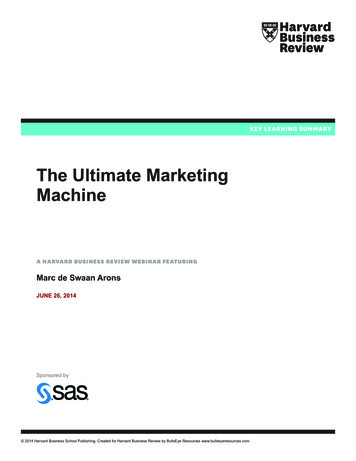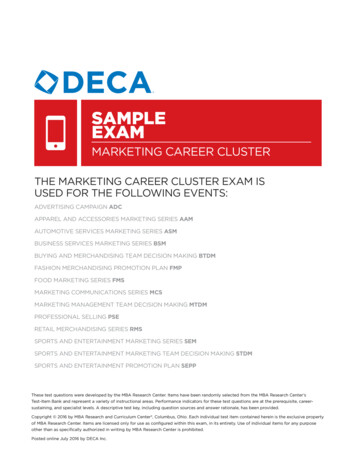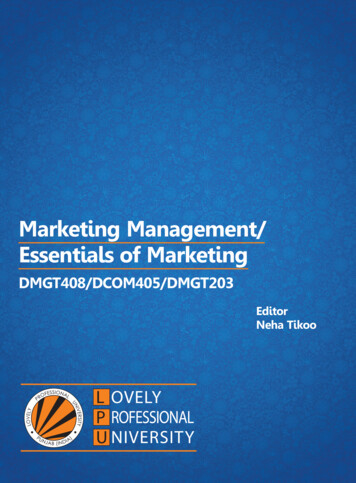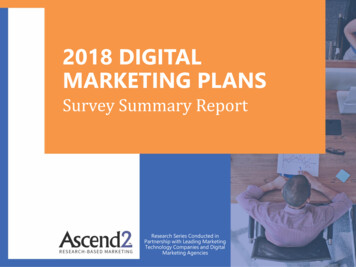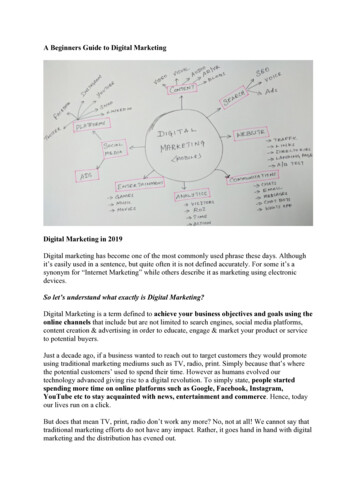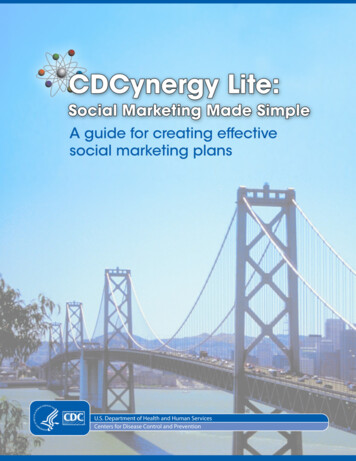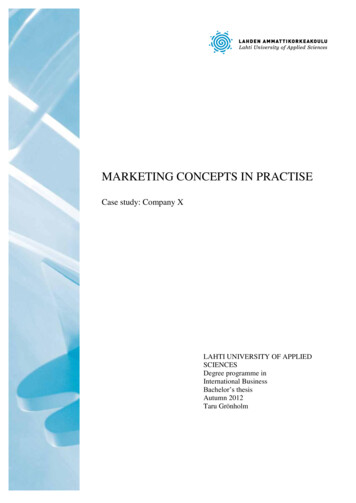
Transcription
MARKETING CONCEPTS IN PRACTISECase study: Company XLAHTI UNIVERSITY OF APPLIEDSCIENCESDegree programme inInternational BusinessBachelor’s thesisAutumn 2012Taru Grönholm
Lahti University of Applied SciencesDegree Programme in International BusinessGRÖNHOLM, TARU:Marketing concepts in practiseCase: Company XBachelor’s Thesis in International Business, 41 pages, 4 pages of appendicesAutumn 2012ABSTRACTThe purpose of this thesis is to study what are marketing and business concepts,how marketing and business concepts can be used in designing concept changes,and how the concepts work in practice. The thesis is comissioned by Company X.In the theoretical part, the thesis covers areas of marketing concepts and businessconcepts. Marketing concept includes the marketing research, marketsegmentation, and marketing mix. The business concept includes businessstrategies, strategic renewal models, brand image, and operational concepts ofservice business briefly.The empirical part of the thesis consists of a qualitative case study. In the studythe case companys concept change was studied under the models introduced in thetheoretical part. Data was collected by unstructured interviews.The study shows that marketing concepts are still used in designing new concepts.Key words: Marketing concept, marketing mix, concept change
Lahden ammattikorkeakouluLiiketalouden koulutusohjelmaGRÖNHOLM, TARU:Marketing concepts in practiseCase study: Company XBachelor’s Thesis in International Business, 41 sivua, 4 liitesivuaSyksy 2012TIIVISTELMÄTämän opinnäytetyön tarkoituksena on tutkia mitä markkinointi- jaliiketoimintakonseptit ovat, kuinka markkinointi- ja liiketoimintakonseptejavoidaan käyttää konseptiuudistuksen suunnittelussa, ja kuinka konseptit toimivatkäytännössä. Opinnäytetyö on Yritys X:n hankkeistama.Teoreettinen osuus käsittelee markkinointi- sekä liiketoimintakonsepteja.Markkinointikonsepti osuus sisältää markkinointitutkimuksen, segmentoimisensekä markkinointimixin. Liiketoimintakonsepti osuus käsitteleeliiketoimintastrategioita, liiketoiminnan uudistamis malleja, tuotekuvaa, sekälyhyesti palvelullisen alan operatiivista konseptia.Opinnäytetyön empiirinen osuus koostuu laadullisesta tapaustutkimuksesta.Tutkimuksessa tutkitaan kohdeyrityksen kokemaa konseptimuutosta teoreettisenosuuden kuvaamien mallien pohjalta. Tutkimustiedon keruu suoritettiinepämuodollisilla haastatteluilla.Tutkimus osoittaa, että markkinointikonsepteja ja markkinointimixiä voidaankäyttää konseptiuudistuksen suunnittelussa.Asiasanat: markkinointikonsepti, markkinointimix, konseptiuudistus
CONTENTS1234INTRODUCTION11.1Background of the thesis11.2Study objectives and research questions11.3Limitations of the thesis21.4Theoretical framework21.5Research methods31.6Structure of the thesis4MARKETING CONCEPTS52.1Marketing strategy52.2The marketing concept52.3Marketing research52.4Market segmentation62.5Marketing mix6BUSINESS CONCEPTS153.1Business concept153.2Business strategy153.3Strategic renewal163.3.1New core business vs. a face-lift of the old163.3.2Blue Ocean Strategy173.4Brand image183.4.1Positioning193.4.2Brand identity prism203.4.3Brand crystalising203.5Operational concept of service business20SHOE RETAIL INDUSTRY224.1In Europe224.1.1Consumption224.1.2Buying habits, segmentation, and trends234.2In Finland244.2.1Consumption244.2.2Buying habits, segmentation and trends264.2.3Competitors27
567CASE STUDY: COMPANY X325.1Company X chain in brief325.2Company X in brief325.3Towards the concept change335.3.1Target customer groups345.3.2Product range345.3.3Store outlook face-lift355.3.4From design into practise365.3.5Marketing procedures365.3.6Online store365.3.7Competitive advantages of the new concept375.4The concept change in Company X38CONCLUSION AND RECOMMENDATIONS396.1Conclusion396.2Reliability and validity406.3Suggestions for future research40SUMMARYREFERENCES4142
LIST OF FIGURESFIGURE 1. Research framework2FIGURE 2. Structure of the thesis4FIGURE 3. The 4 P’s of marketing (Adapted from NetMBA,2010b)7FIGURE 4. Intergrated marketing communications12(Adapted from on Anttila et.al 1993, 236)FIGURE 5. Value Innovation (BOS 2012b)18FIGURE 6. Shoe sales in Finland 2011 (PTY 2012, 33)26
LIST OF TABLESTABLE 1. EU consumption of footwear 2004-2008, million / millions of pairs(CBI 2010, 6)23TABLE 2. Shoe sales 2006-201125(Adapted from PTY annual reports 2007-2012)TABLE 3. Hypermarket SWOT analysis28TABLE 4. E-commerce SWOT analysis29TABLE 5. Shoe retail stores and chains SWOT analysis31
11.1INTRODUCTIONBackground of the thesisMarketing concepts are built and developed to satisfy the needs and wants ofcustomers. In the competitive fashion industry, companies are forced to put moreeffort and thought into their marketing plans and means of attracting thecustomers in the first place.The fashion industry has grown massively in the past couple of years. Youngergenerations are grown in an era where appearance is seen as an asset. People areconstantly in touch with fashion. Magazine stands are filled with fashionmagazines and television is filled with makeover shows where people with badappearance are groomed to be more attractive. As media feeds us with laws oflooking good, people are spending more money on their own appearance. As thetarget markets have grown, so has the industry.As competition has become harder, businesses are forced to get back to the basics;business and marketing concepts. The importance of functioning marketing hasraised its head partly due to stiffeningcompetition and partly to tighteningeconomical situation. Identifying target customers and their needs is crucial forboth the customers and the businesses wallet.Work as a sales assistant in Company X has caught the author’s interest toconduct a study related to the footwear industry in Finland and to study theimportance of business and marketing concepts in today’s markets.1.2Study objectives and research questionsThe scope of the study is to recognize what marketing and business conceptsconsist of and how those concepts can be used and utilized to meet changingcustomer preferences more effectively.The main study objective is to analyse the steps taken in the concept changecarried out in Company X in accordance with the marketing and business concept.
2Research questions asked are:1.3-What are marketing and business concepts?-How can marketing and business concept be utilized by companies?-How do the concepts work in practice?Limitations of the thesisThe thesis does not include economical matters related to marketing and businessconcepts in general nor in the case companys case. Figures – budgets, costs,profits – concerning the conceptual changes carried out in the case company arealso not studied. The thesis mainly concentrates on the steps taken in the processof renewing and building a new business concept.1.4Theoretical frameworkThe thesis includes theory of marketing and business concepts. Figure 1 shows theresearch framework for the theoretical part of the thesis. It describes therelationship between basic concepts.Market knowledge- research- segmentation- marketing mixBusiness knowledge- strategy- strategic renewal- brand imageCustomer satisfactionCompetitiveadvantageFIGURE 1. Research frameworkIn addition to marketing and business concepts, the theoretical part of the thesisbriefly covers the footwear industries in Europe and in Finland.
3In the theoretical part of the thesis, written sources of books and articles as well asinternet sources are used as references in the research process.1.5Research methodsThe empirical part of this thesis consists of a qualitative case study of a shoe retailstore Company X. The study is deductive in nature as the case company is studiedon the grounds of the common marketing and business concept models.In this study unstructured interviews and conversations were used to obtain awider picture of the concept change and the means taken to conduct the change inthe case company. In addition, as the author is an employee at the case company,participant observation could also be used as a data collection method.Unstructured interviews are direct interactions between the researcher and therespondent. Although the researcher may have some initial guiding questions orcore concepts, the researcher and the respondent may freely move theconversation in direction of interest. However, the data collected throughunstructured interviews may be harder to analyze as every interviewing situationis different and conversation topics can vary. (Trochim 2006)Participant observation is one of the most common and demanding methods ofqualitative methods. In participant observation the researches becomes a naturalpart of the group, culture and context observed. With participant observation aclear picture of a natural phenomenon can be obtained. However, usually thistakes years as it is hard for the researcher to become a natural part of an existinggroup. (Trochim 2006)In this study, however, the researcher is already a part of the observed group asthe researcher has worked in the case company for nine months. Before workingin the case company, the researcher worked at former Andiamo Trio in Lahti(present KOOShoes Karisma, Lahti) for 11 months. The researcher has been apart of the concept change process in both stores. In addition to unstructuredinterviews and participant observation, chain handbook was used as a sourcematerial.
41.6Structure of the thesisThe thesis consists of seven chapters as shown in Figure 2. Chapter 1 is anintroduction to the thesis followed by the theoretical part in chapters 2, 3 and 4.Chapter 5 begins the empirical part of the thesis with an introduction to the casecompany followed by the study of the new concept of the case company. Chapter6 consist of the the conclusions and suggestions of the study followed by Chapter7 which concludes the thesis as a summary.1 Chapter 1. Introduction Background ,Objectives, Research questions ,Limitations ,Research methods, Structure2 Chapter 2. Basic concepts in marketing Marketing strategies, Marketing concepts Marketing research, Segmentation, Marketingmix3 Chapter 3. Business concepts Business concepts, Business strategies, Strategic renewal, Brand image, Operationalconcepts4567 Chapter 4. Shoe retail industry Industry in Europe and in Finland Chapter 5. Case: Company X Company X chain in brief, Company X in brief, Towards the concept change, From designto practise Chapter 6. Conclusion and recommendations Conclusion, Reliability and validity, Suggestions for future research Chapter 7. SummaryFIGURE 2. Structure of the thesis
522.1MARKETING CONCEPTSMarketing strategyMarketing strategy beholds businesses all marketing goals. Marketing strategy is,ideally, built around market research to create an ideal product mix to achievemaximum profit potential. (Business Dictionary, 2012a) Marketing strategy isstated in businesses marketing plan which can be product specific, market specificor company-wide plan. Organizations market plan illustrates activities to be takenin achieving the businesses marketing objectives in a specific timeframe. Firststep to market plan is to perform a market research to identify specific customerneeds and steps to fulfill them, while generating profit. Analysis of current marketsituations, action programs, budgets, sales forecasts, strategies, and financialstatements are also included. (Business Dictionary, 2012b)2.2The marketing conceptThe marketing concept is a philosophy which states that the key to achievinggoals is to determine the needs of the target customers and to satisfy those needsmore efficiently and effectively than competitors. The marketing concept does nottarget to maximize profitable sales volumes but to generate profits throughcustomer satisfaction. Therefore, the emphasis is not solely on selling productsbut on selling satisfaction. (Chopra 2012, 239-240) The marketing concept resortsto marketing research, which defines the market segments, the size of segments,and the needs of the segments. In order to satisfy the needs of the target marketsthe marketing mix can be used to create a strategy. (NetMBA 2010a)2.3Marketing researchMarketing research is a method of obtaining a wide range of information andactivities necessary to run a business. Marketing research covers gathering,recording, and analysis of information about transfer and sale of goods andservices from producer to consumer. The objective of marketing research is tooffer analyzed facts and knowledge in order to over come problems and to make
6the right marketing decision at a right time. Every company must research itsmarkets, customers and competition in order to go in the right direction and beprofitable. Continuous monitoring is the key in staying in the right course asmarkets can change rapidly and customer preferences and needs may shift awayfrom the previous results. (Chopra 2012, 242)2.4Market segmentationA market holds a large number of individual customers who have different needs,preferences and buying habits and capacities. Market segmentation is the divisionof this total market into different customer groups. Each customer group hascharasteristics that include the customer into the specific group. Not only doesmarketing segmentation enable a company to match their marketing efforst to theneeds of the target market, marketing segmentation also shows which customergroups not to target. Market segmentation can be done on the basis of geographic,demographic, psychological, and behavioural variables. (Chopra 2012, 243-244)2.5Marketing mixMarketing mix describes the set of tools that can be used to impact sales.Although Neil H. Birden used the term marketing mix in his teaching already inthe late 1940’s, the term popularized in 1964 after Bordens article “The Conceptof the Marketing Mix”. Bordens marketing mix included product, planning,pricing, branding, distribution channels, personal selling, advertising, promotions,packaking, display, servicing, physical handling, and fact finding and analysis. Itwas E. Jerome McCarthy who later compressed Bordens marketing mix into the 4P’s of marketing that are known today; product, price, place, and promotion.(NetMBA 2010b)
7FIGURE 3. The 4 P’s of marketing (Adapted from NetMBA,2010b)Figure 3 shows what is included in the 4 P’s of marketing. The figure also showsthat although Bordens initial marketing mixture was compressed to the 4 P’s, themodel still includes the same ingredients of marketing as before. Becausemarketing has moved to be more integrated into organizations rather than justbeing marketing concepts of physical products, some authors have suggested thatmore P’s should be added to the mix; packaging, people, process, etc. (NetMBA2010b)In his article “The 7 P’s of Marketing”, Brian Tracy ads packaging, positioning,and people to the already existing 4 P’s. Tracy emphasizes the importance ofcontinually revisiting and revaluating the 7 P’s in order to stay ahead of therapidly changing markets. (Tracy 2004)
8ProductProduct can be defined in many different ways. In marketing, product means thephysical products and service offered, and the ideological actions of the company.In this definition the product is the shop, industry product the manufacturedgoods, and organizations product an event or campaign organized. Often productis defined as the benefitting factors that a customer gets when purchasing theproduct. In this definition the customer and the benefits of the product is verymuch highlighted. (Anttila&Iltanen 1993, 21)When purchasing a product, consumers expect to benefit from it. The expectationsare based on their own needs and the product is purchased to satisfy those needs.Consumer needs can be divided into three main categories; functional needs,symbolic needs, and experimental needs. The functional needs relate toconsumption and the consumers problems related to consumption. The symbolicneeds are based on the consumers internally generated needs that relate to selfimage and social behavior. Experimantal needs are based on enjoyment,experience, and desire of change. (Anttila et.al 1993, 22)As product is the most important piece of the marketing mix it is advisable forcompanies to develop a habit of looking and evaluating the companys actionsthrough an outside marketing consultants eye. Asking critical question relating tothe products or services provided is the key. Forgetting to assess the need,appropriability, and suitability of provided product or service in the presentmarkets can be crucial. (Tracy, 2004) The product lifespan is continuouslyshorthening in today’s markets. Therefore it is crucial to continuously develop theproducts and services offered so that the needs of consumers can be fulfilled andsolutions to consumer problems can be provided. (Anttila et.al 1993, 21)PricePrice is defined as the price of the products and services provided. It includes allof the pricing related matters such as the retail prices, volume discounts, terms ofpayment, seasonal discounts, and credit terms. Price is usually seen as both theeasiest and the hardest mean of competition at the same time. It is easy to compareprices with competitors selling the same products or services. However, the hard
9part is to figure out with what price the profit marging and profitability will bekept on the pursued level of the company. Too low pricing may mean low profitwhereas too high pricing may mean that a company prices itself out from themarkets. Due to possible price wars, companies are careful with using price as acompetitive mean. Other means such as quality of the product, quality of theservice, terms of payment, and marketing have gained more meaning.Recognizing and selling also the strengths of the company can influence the price.(Anttila et.al 1993, 173-174)Examining and evaluating prices regularly is a key to success. Companies shouldnot be afraid to revise their prices and to recognize that the current pricingstructure may not be ideal for the current market. (Tracy, 2004)PlacePlace means the availability of the product and service sold. This includes themarketing channels used as well as the physical distribution of the goods(transportation and warehouse). Availability means removing obstacles betweenthe company and the customer or between the product and the customer so thatthe commodity and the customer meet. Well organized distribution guarantees thatthe commodity is at the right time, at the right place, at right quantities, and at areasonable price available for the customer to purchase. (Anttila et.al 1993, 208)The meaning of place and availability depends on the industry in question. Formanufacturing industry the key is to get the product available for customers asefficiently, economically, and comprehensively enough. For retail trade, the goalis to remove the obstacles between the shop and the customer. This means theaccessibility of the place of sales (shop) and the accessability of the products atthe place of sales. The accessability of the place of sales is influenced by locationin the customers’ passageway, parking possibilities, opening hours, and othercontact connections such as telephone and email. The accessability of the productat the place of sales is influenced by how the products are situated in the shopfloorand how the products are placed to customer circulation. (Anttila et.al 1993, 209)Choosing the right marketing channels is crucial yet limited. Marketing channeldecisions always have two parties; the seller and the buyer. Both have their own
10goals related to the decision making and a deal can not be established if bothparties are not involved. Before choosing a marketing channel, the company hasto be aware of how the product is bought, when the product is bought, where theproduct is bought, and who makes the purchasing decision. Marketing channelsshould always be built backwards starting from the end customer. In their book“Markkinointi” Mai Anttila and Kaarina Iltanen state that revitalizing andexamining companys marketing channels become relevant when-a new company or a product comes to the markets-product reaches a new life point (new competition)-new target group is chosen-present marketing channel choices are made ineffective by competition-the structure of marketing channels changes or new channel possibilitiesarise-marketing strategy is changed-expences force to eliminate customers-legislation or institutional factors impacting the distribution change.Decisions concerning marketing channel choices are to be made with care andconsideration as they are strategic decisions. (Anttila et.al 1993, 2011)Although decisions concerning place should be made with care, truthfullyexamining and analyzing the present channels and the place of sales used isimportant. In order to understand companys present and potential customers andcompany turnover it is crucial to ask “Are you in the right place?” (Tracy 2004)PromotionI don’t know who you are. I don’t know your company. I don’tknow your company’s products. I don’t know your companystands for. I don’t know your company’s customers. I don’tknow your company’s record. I don’t know your company’sreputation. Now – what was it you wanted to sell me? (Anttilaet.al 1993, 231. Translated by author)Promotion includes the means taken to inform the customers of the products andservices provided, including personal selling, advertising, sales promotions, andpublic relations. It is said that a product is completed when customers know it
11exists, know its quality and features, react to it positively, and buy it. Withoutknowledge there can not be demand. Promotion enables product awereness,positive attitudes and buying decisions. (Anttila et.al 1993, 231)Marketing communications are always purposive and goal-driven. The goal is togenerate a change in knowledge or attitude, or to generate a buying decision in thereceiver. Marketing communications is interaction between the company and itsstakeholders, and the purpose is to influence the sales of the sold commodity,either vicariously or directly. (Anttila et.al 1993, 232)Traditionally, marketing communications is divided into four categories: personalselling, public relations, advertising, and sales promotions. While personal sellingand sales promotions are focused to sell the company’s products, advertising aimsto create positive image over the company and products by informing thecustomers. In addition, advertising strives to attract new potential customers.Public relations, on the other hand, aim to maintain the support and understandingof already existing interest groups. (Vuokko 2003, 168-278) Over the years thesefour tools have gotten company from direct marketing, sponsorships, and internalmarketing tools.The tools should not be seen as individual but as an integratedwhole. (Anttila et.al 1993, 236)
12FIGURE 4. Intergrated marketing communications (Based on Anttila et.al 1993,236)Figure 4 shows the intergrated marketing communications model. Intergratedmarketing communications (IMC) is an approach of communications wheredifferent tools work together as a whole. IMCs goal is to create a synergyadvantage where communication tools support eachothers in order to reinforce thecore message. With the IMC a company may-built mental image positioning to the company name and products-create, maintain and reinforce customer relations-adapt to market environment changes and may even guide change.The most significant difference between IMC and a traditional marketingcommunications is the starting point of the plan. In IMC the plan starting point arethe present and potential customers whereas traditional marketingcommunications emphasize company sales and profit goals. Segmentationbecomes crucial. (Anttila et.al 1993, 234-237)
13In IMC customer behavior is used as the basis to the segmentation. Usingcustomer behavior as the strating point to planning ensures customer behavior inthe future more certainly than different intentional and attitude approaches.(Anttila et.al 1993, 242)Even the smallest changes made to marketing and to the way company promotesitself may lead to drastic results in for example profits. Both large and smallcompanies experiment with advertising and promoting with an intention toincrease sales. Tracy offers a crucial rule to all companies: What ever method ofmarketing and sales you’re uing today will, sooner or later, stop working.Continually renewing and searching for new methods and strategies of marketingis essential in survival. (Tracy 2004)PackagingThe fifth element of the marketing mix is packaging. Packaging has many levelsas it refers to the oulook of the compnys product or service sold, to the appearanceof the personnel, office, brochures, correspondence, and every visual elemenetabout the company. Everything visible affects customer’s confidence and mentalimage over the company. Customers form their first impressions over thecompany within the first 30 seconds of seeing the sales person or some otherelement of a company. For example if a salesperson is physicly in contact with thecustomer the salesperson should posses a high level of confidence and credibility.If the salesperson does not know the product, hesitates and is not on top of thesales situation, there is a lack of confidence which may affect the customernegatively. (Tracy 2004)Scrutinizing the visual elements through the eyes of customers is a key to success.Going through the customer contact process from the beginning when thecustomer enters the store through the purchasing process to the cashier companiescan make visual changes to the things that the customer sees. (Tracy 2004)PositioningThe sixth element of the marketing mix is positioning. In his article “The 7P’s ofMarketing” Brian Tracy introduces a book called Positioning. In the book the
14authors Al Reis and Jack Trout state that the most critical determinant of successin a competitive marketplace is how the company is seen and thought about by thecustomers. According to attribution theory most customers link a single attribute,positive or negative, with a company. Whether the attribute is “service”, “quality”or “unethical”, how established that attribute is in the mind of the customerdetermines whether the customers will buy the product or service and how muchthey are ready to pay for it. Changing the company positioning is not impossiblebut requires hard work from every participant. Having a clear vision over what isthe companys present position and what would be the ideal position is the key.(Tracy 2004)PeopleThe seventh and the final element of the marketing mix is people; getting the rightpeople to the right jobs. In his article “Good to Great” Jim Collins points out thatthe best companies get “the right people on the bus, and the wrong people off thebus”. The second step is to “get the right people in the right seats on the bus”.Companies may use countless hours on making plans and strategies but forget topay attention to the people who carry them out. In terms of success the mostimportant factor is the ability to select, recruit, hire and retain the right peoplewith the right skills and abilities. (Collins 2001) If a company fails to have theright people in the right places doing the right assignments it may not be possibleto move forward. Acknowledging the weak links and recognizing the potentials inpeople brings along opportunities. (Tracy 2004)The 4 and the 7 P’s have been critisised to present more of the sellers point ofview than the customers. Robert Lauterborn has suggested that before companiesutilizise the 4 P’s, they apply the 4 C’s of marketing. The 4 C’s of marketing arecustomer value, customer costs, convenience, and communication. It has beenargued, that only after taking a closer look at the 4 C’s from the target customerspoint of view can a company truly utilizise the 4 P’s readily. In addition, PhilipKotler has argued that the 4 P’s could be renamed. Kotlers vision of the 4 P’s isconfiguration, valuation, facilitation, and symbolization. (Kotler 2003, 91-94)
153BUSINESS CONCEPTS3.1Business conceptThe word concept refers to the planning and executing of business activity interms of the businesses spirit and the desirable brand image. The detailed businessconcept is a functional and concrete outcome of a business idea. (Sammallahti,11) Marketing is a way of reaching the target consumer groups through differentchannels. However, before a balanced business concept can be developed or isdeveloped, the strategy of the business has to be clear.3.2Business strategyBusiness strategy is a long-term plan of achieving goals and objectives of thebusiness through different actions. A well structured business strategy, however,does not guarantee success. The key to good business strategy is to be able toadapt to unforeseen circumstances and to be able to develop the strategy to a newdirection. Businesses that trust their business strategy whole heartethly are weak.A business strategy is more that just a timeline of activities to be taken.World know strategy guru Henry Minzberg defines business strategy as follows:-Strategy is a purposive plan of the future of the business.-Strategy means the consistent, thus not always planned ahead, actions.-Strategy is the businesses chosen position in the markets.-Strategy is a vision of the businesses future state.-Strategy is a business economical scheme. (Sammallahti 2009, 27)Nearly every field of business is filled with service providers selling the sameservices to customers. Businesses are feeling the pressure of competition which isseen as low profit or even unprofitable business activity. The continuous battle tosurvive takes its toll on productivity and employees, and may even narrow theperspective of business activity. In developing a new business or renewing an oldone it is crucial to stop
to marketing research, which defines the market segments, the size of segments, and the needs of the segments. In order to satisfy the needs of the target markets the marketing mix can be used to create a strategy. (NetMBA 2010a) 2.3 Marketing research Marketing research




